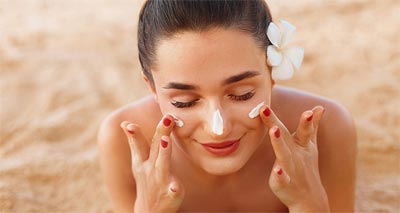
In order to maintain skin that is healthy and youthful with a clear complexion, it is critical that you add sunscreen to your routine when needed. Although our bodies need the vitamin D from the sun, it’s important to protect yourself from its harmful side effects on our skin. Lucky for us, sunscreen provides these essential protection measures against the harmful rays of the sun.
How Does the Sun Harm the Skin?
Certain rays from the sun are harmful to the skin, specifically UVB and UVA ultraviolet rays. UVA rays are able to penetrate to the deeper levels of the dermis, which can cause aging as well as loss of skin elasticity. UVB rays, on the other hand, wreak havoc with the skin cell structure which can even lead to serious conditions such as cancer. UVC rays are also harmful, but the earth’s ozone layer prevents them from reaching the surface.
What is Broad Spectrum & How Does Sunscreen Work?
When you see a sunscreen that is labeled broad-spectrum, it means that it has the ability to protect you from both UVB and UVA rays. Sunscreen protects your skin by repelling most UV rays from your skin and absorbing the remaining rays that make it through. Some sunscreens such as those that have a physical blocker are even more effective.
What is Chemical Sunscreen?
These types of sunscreen absorb the UV rays from the sun. They are made from chemicals such as octisalate, octinoxate, and avobenzone. You may find some that contain oxybenzone, though it is banned in most countries. These help to filter and reduce the radiation emitted from UV rays. Unlike physical sunscreen, the chemical version soaks into the skin. Over time, these can cause inflammation and even cause aging due to free radical damage.
What is Physical Sunscreen?
These types of sunscreen create a physical barrier along the skin. This physical barrier reflects the UV rays that come from the sun. Most are made from Titanium Dioxide and Zinc Oxide. In addition, most also feature anti-inflammatory properties and also offer broad-spectrum SPF capabilities.
All About SPF
Sun Protection Factor, most commonly referred to as SPF. This number is a ratio that determines how much radiation is blocked when a particular sunscreen is used. There are many different SPF available on the market. The higher the number, the lower the amount of radiation you will be exposed to. For example, SPF 30 will block 3.4% of UV radiation or rather protection from 97.3% of UV rays. SPF 15 offers 93% protection. SPF 50 on the other hand offers 97.8% protection. It is important to know that no matter which level of sunscreen you use, the amount of time that you should be in the sun remains equal across all forms. Additional protection such as hats, umbrellas, long sleeves, and staying in the shade should also be used.
How to Properly Apply Sunscreen
Any skin that will be exposed to the sun should be treated with sunscreen at least half an hour before going outside. Make sure to use a generous amount and apply it evenly over dry skin. To ensure that you stay protected, reapply sunscreen every two hours. An adult should use 5ml per appendage as well as the face, back, and body. A child will need approximately half of that amount. Babies should also use sunscreen, but only the physical variety.
Always Bring Your Sunscreen
It’s always better to be safe than sorry. If you’re looking for more information as to why you should protect your skin with sunscreen, we have you covered! Browse through our skin blogs to learn how to properly protect your skin. For the latest new blog updates, follow our social media accounts!
